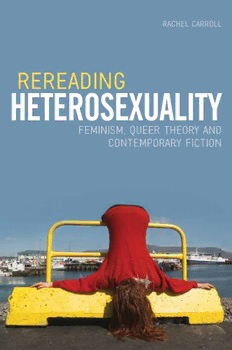
Rereading Heterosexuality: Feminism, Queer Theory and Contemporary Fiction PDF
Preview Rereading Heterosexuality: Feminism, Queer Theory and Contemporary Fiction
RaChel CaRRoll ReReading Heterosexuality Feminism, QueeR TheoRy and ConTempoRaRy FiCTion Rereading Heterosexuality CCAARRRROOLLLL 99778800774488663399555577 PPRRIINNTT..iinndddd ii 2211//0022//22001122 1144::4400 CCAARRRROOLLLL 99778800774488663399555577 PPRRIINNTT..iinndddd iiii 2211//0022//22001122 1144::4400 Rereading Heterosexuality Feminism, Queer Theory and Contemporary Fiction Rachel Carroll CCAARRRROOLLLL 99778800774488663399555577 PPRRIINNTT..iinndddd iiiiii 2211//0022//22001122 1144::4400 © Rachel Carroll, 2012 Edinburgh University Press Ltd 22 George Square, Edinburgh EH8 9LF www.euppublishing.com Typeset in 10.5/13 pt Sabon by Servis Filmsetting Ltd, Stockport, Cheshire, and printed and bound in Great Britain by CPI Group (UK) Ltd, Croydon, CR0 4YY A CIP record for this book is available from the British Library ISBN 978 0 7486 3955 7 (hardback) ISBN 978 0 7486 4908 2 (webready PDF) ISBN 978 0 7486 4928 0 (epub) ISBN 978 0 7486 4927 3 (Amazon) The right of Rachel Carroll to be identifi ed as author of this work has been asserted in accordance with the Copyright, Designs and Patents Act 1988. CCAARRRROOLLLL 99778800774488663399555577 PPRRIINNTT..iinndddd iivv 2211//0022//22001122 1144::4400 Contents Acknowledgements vii Introduction: feminism, queer theory and heterosexuality 1 Part One: Revisiting the spinster 1. ‘Becoming my own ghost’: spinsterhood and the ‘invisibility’ of heterosexuality in Sarah Waters’ Affi nity 25 2. Telling tales out of school: spinsters, scandals and intergenerational heterosexuality in Zoë Heller’s Notes on a Scandal 45 Part Two: Transgressive female heterosexuality 3. Queering Alice, killing Lolita: feminism, queer theory and the politics of child sexuality in A. M. Homes’s The End of Alice 67 4. Unauthorised reproduction: class, pregnancy and transgressive female heterosexuality in Alan Warner’s Morvern Callar 91 Part Three: Reproducing heterosexuality 5. ‘First one thing and then the other’: rewriting the intersexed body in Jeffrey Eugenides’ Middlesex 111 6. Imitations of life: cloning, heterosexuality and the human in Kazuo Ishiguro’s Never Let Me Go 131 Bibliography 149 Index 157 CCAARRRROOLLLL 99778800774488663399555577 PPRRIINNTT..iinndddd vv 2211//0022//22001122 1144::4400 CCAARRRROOLLLL 99778800774488663399555577 PPRRIINNTT..iinndddd vvii 2211//0022//22001122 1144::4400 Acknowledgements Some of the material contained in this book has been published previ- ously; I would like to thank the publishers for permission to reproduce work from the following publications: • ‘ “Becoming my own ghost”: spinsterhood, heterosexuality and Sarah Waters’s Affi nity’, Genders (Spring 2007), n.p. • ‘Imitations of life: cloning, heterosexuality and the human in Ishiguro’s Never Let Me Go’, Journal of Gender Studies, 19: 1 (2010), pp. 59–71. • ‘Retrospective sex: rewriting intersexuality in Jeffrey Eugenides’s Middlesex’, Journal of American Studies, 44: 1 (2010), pp. 187–201. I am very grateful to my friends Heike Salzer and Ingi Jensson for allow- ing me to use a still image from their work for the cover of this book. CCAARRRROOLLLL 99778800774488663399555577 PPRRIINNTT..iinndddd vviiii 2211//0022//22001122 1144::4400 CCAARRRROOLLLL 99778800774488663399555577 PPRRIINNTT..iinndddd vviiiiii 2211//0022//22001122 1144::4400 Introduction: feminism, queer theory and heterosexuality The ‘invisibility’ of heterosexuality as a normative category of identity is a recurring motif in recent work on heterosexuality; its ‘ “unmarked” and “naturalised” ’1 status is understood as serving to perpetuate its power as an identity which tends to be taken for granted and to pass unquestioned. Indeed, as Linda Schlossberg puts it, ‘heterosexual culture continually passes itself off as being merely natural, the undisputed and unmarked norm [emphasis added].’2 Rereading Heterosexuality: Feminism, Queer Theory and Contemporary Fiction aims to contrib- ute to what Richard Johnson has described as the ‘impetus to render heterosexuality visible to critical scrutiny’.3 Heterosexuality as an insti- tution continues to have immense normative power; while this power impacts most explicitly on non-heterosexual identities it also extends to heterosexual identities which do not conform to familial, marital or reproductive norms – norms which have a particular impact on female identities, the principal concern of this book. Drawing on feminist and queer theories of sex, gender and sexuality, Rereading Heterosexuality takes as its distinctive focus the representation of female identities at odds with heterosexual norms; more specifi cally, it explores representa- tions which serve to question the conventional equation between hetero- sexuality, reproductive sexuality and female identity. In this context, it will offer close readings of six novels published by British and American authors between 1995 and 2005: Morvern Callar by Alan Warner (1995), The End of Alice by A. M. Homes (1996), Affi nity by Sarah Waters (1999), Middlesex by Jeffrey Eugenides (2002), Notes on a Scandal by Zoë Heller (2003) and Never Let Me Go by Kazuo Ishiguro (2005). The diverse subject matter of these novels refl ects contemporary concerns and anxieties about the future of sex, gender and sexuality; some address topics which have been the focus of media attention and social policy debate, including child sexual abuse, human cloning and transgender identity, while others turn to historical periods which have CCAARRRROOLLLL 99778800774488663399555577 PPRRIINNTT..iinndddd 11 2211//0022//22001122 1144::4400
